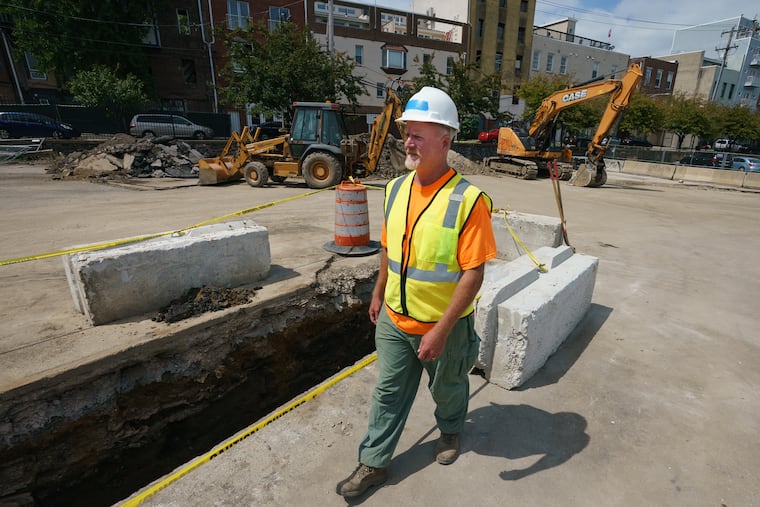Philadelphia’s 18th-century waterfront emerges during archaeological dig on Columbus Boulevard
The West Shipyard site yields more evidence of the city's early shipbuilding days as archaeologists excavate in advance of development.

Archaeologists exploring the old West Shipyard site along Columbus Boulevard just north of the Benjamin Franklin Bridge have uncovered remnants of what is likely an early to mid-18th century wharf — a big hand-hewn timber, bolstered by what are called “dead men” beams, all relics of the city’s early seafaring days, the archaeologists said Monday.
The discovery, a significant sign of the site’s archaeological potency, came within the last two weeks, when archaeologists opened one of three test excavations.
The work is being performed at the behest of the developer, New York City’s Durst Organization, which has an agreement of sale on the property with the Delaware River Waterfront Corp.
The site is on the National Register of Historic Places and is certified by the Philadelphia Historical Commission because of the high probability of important archaeological remains tracing back into the 17th century.
“This is pretty exciting,” said Douglas Mooney, an archaeologist with AECOM, the New Jersey-based international engineering firm hired by Durst to perform the work.
Mooney cited as important the stone foundation uncovered by another test trench — the remains of a mid-to-late 18th century building that could have been constructed on the wharf.
“That’s the earliest building found on the site,” he said. “We do know that buildings were built right on the wharves here.”
Shipbuilding on the site began with James West, who constructed a small shipyard around 1680. His descendants added to his holdings, building wharves and related structures northward along what was then the river bank, right off Water Street.
Because of landfill activity proceeding from virtually the city’s earliest days, the river is now 500 feet away.
In the 1980s, the city conducted an excavation a bit to the north of the current dig, and uncovered 18th century wharves, bulkheads, and a slipway used for hauling boats out of the river for repair. It is the only such structure ever found on the East Coast. The results of that excavation were left in the ground and covered over again.
In 2012, another excavation, conducted at the behest of the DRWC, uncovered great stones and beams, more evidence of 18th century waterfront construction.
Because of the historical sensitivity of the site, DRWC required archaeological testing in advance of any construction. The site is facing Dave & Buster’s across Columbus Boulevard.
Construction will be monitored by archaeologists and could begin next spring if Durst closes on the sale.
Mooney said the location of the large timber and its supporting beams, near the corner of Columbus and Vine Street, lines up with the location of a West Shipyard wharf that appears on a 1762 map. He said it is not possible, at least at this point, to date the timber except to note that it was there in 1762.
Precisely when the wharf was constructed remains unknown.
In addition to the wharf remnants, the dig has uncovered a cache of artifacts, many dating to the early to mid-1700s, including a considerable number of ceramic fragments and what Mooney called “a sweet, beautiful pipe bowl.”
The excavation will be complete and covered over by the end of this week. Archaeologists will then analyze the findings and submit a report.
Anthony Campisi, a Durst spokesman, said Monday that the developer wants to study the archaeological findings and incorporate them into the final building design.
“There is no final plan now,” he said. “Our goal is to be thoughtful but to move forward.”